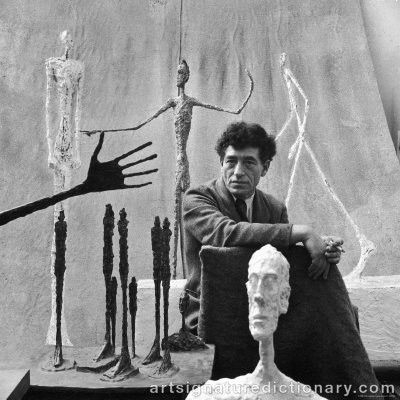
Alberto GIACOMETTI
1901–1966, Switzerland/Italy
Also known as: AG
Biography
Discover the life and artistic journey of Alberto GIACOMETTI (born 1901, 10/10, Switzerland, died 1966, 11/1, Switzerland), including key biographical details that provide essential context for signature authentication and artwork verification. Understanding an artist's background, artistic periods, and career timeline is crucial for distinguishing authentic signatures from forgeries.
Alberto Giacometti wird am 10.10.1901 im schweizerischen Borgonovo als Sohn des neoimpressionistischen Malers Giovanni Giacometti geboren. 1919 beginnt er in Genf ein Kunststudium an der École des Beaux-Arts sowie an der École des Arts Industriels. 1922 geht Alberto Giacometti nach Paris, wo er biss 1925 an der Académie de la Grande Chaumière die Bildhauerklasse von Antoine Bourdelle besucht.
Ab 1925 bezieht er gemeinsam mit seinem Bruder Diego ein Atelier in Paris. In den folgenden Jahren lernt Giacometti an den Beispielen der postkubistischen Bildhauerei, etwa von Jacques Lipchitz und Constantin Brancusi, selbst großzügiger und plastisch-räumlicher zu arbeiten. Ab 1925 orientiert sich Alberto Giacometti auch an der plastischen Kunst der Naturvölker, wie an dem im Jahr 1925 entstandenen Torso abzulesen ist.
Ab 1926 entstehen die "Plates" – abgeflachte Figuren in dünner Scheibenform, so etwa das Werk Femme-cuiller von 1926-27, mit nahezu glatter Oberfläche, auch Gips oder in Marmor umgesetzt. Mit diesen Arbeiten erregt Alberto Giacometti auch die Aufmerksamkeit des Pariser Surrealisten-Kreises. Er schließt sich ihnen vorübergehend an, nimmt auch an deren Ausstellungen teil, bis es 1934 zum Bruch kommt. In dieser Zeit entstehen surrealistische Plastiken und auch Zeichnungen.
In der zweiten Hälfte der 1930er Jahre arbeitet Alberto Giacometti an Kopfstudien. Seine Figuren werden immer kleiner, mitunter nur zentimetergroß. Daneben entstehen Gemälde und Zeichnungen, das malerische Werk ist für ihn später durchaus von gleichrangiger Bedeutung. Seinen Lebensunterhalt verdient sich Alberto Giacometti gemeinsam mit seinem Bruder Diego Giacometti mit Entwürfen für Lampen und Möbel, die sie für den Pariser Innendekorateur Jean-Michel Frank anfertigen.
Die Kriegsjahre 1939-45 verbringt Alberto Giacometti in Genf. Dann kehrt er nach Paris zurück, wo nun dünne, fasst masse- und gewichtslose sowie gelängte Figuren aus Bronze entstehen, deren Magerkeit noch verstärkt wird durch einen vergleichsweise kompakten Unterbau, auf den Giacometti die Gestalten setzt. Alberto Giacometti findet zu seinem so unverwechselbaren Stil, verleiht durch die Reduktion und die ungeheure Verdichtung seinen Figuren ein Höchstmaß an Ausdruck. Das Verhältnis zwischen Figur und Raum wird zum Kernthema der künstlerischen Arbeit.
1948 findet in New York in der Pierre Matisse Gallery die erste Einzelausstellung statt, in der die stabdünnen Plastiken zu sehen sind. Sie wird zum großen Erfolg und bringt den künstlerischen Durchbruch.
1958-65 entsteht die Folge von 150 Lithografien "Paris sans fin". Das malerische Werk beinhaltet zahlreiche Bildnisse seines Bruders, seiner Frau und von Freunden, Landschaften, Stillleben sowie Atelierbilder. Vorherrschend besonders in den Bildnissen ist auch hier das Spannungsverhältnis der schlanken Gestalt zu Fläche und Bildraum.
Alberto Giacometti stirbt am 11.1.1966 in Chur.
Alberto Giacometti was born son of the neo-impressionist painter Giovanni Giacometti in the Swiss town of Borgonovo on October 10, 1901. He begins his art studies at the École des Beaux-Arts and the École des Arts Industriels in Geneva in 1919. Three years later he goes to Paris, where he attends the sculpting class of Antoine Bourdelle at the Académie de la Grande Chaumière until 1925.
He starts his first studio together with his brother in Paris in 1925. His sculpting style becomes more lavish and spacious, following the post-cubist sculptures of, for example, Jacques Lipchitz and Constantin Brancusi. As of 1925 he finds inspiration in plastic art of primitive people, as can be observed on the torso from 1925.
He executes the "Plates" as of 1926 - flat figures in form of thin slices, for instance the work Femme-cuiller from 1926-27, with an almost smooth and even surface, he also uses gypsum and marble for these objects that call the attention of the Paris circle of surrealists. He joins them for some time, also showing works in their exhibitions, until they break up in 1934. During this period he makes a lot of surrealist plastics and also drawings.
In the second half of the 1930s Alberto Giacometti works a lot on studies of heads. His figures get smaller and smaller in size, sometimes they are not bigger than just a few centimeters, but painting remains a just as important means of artistic expression for him. He and his brother Diego earn a living by making designs for lamps and furniture for the Parisian interior architect Jean-Michel Frank.
Alberto Giacometti spends the war years from 1939 to 1945 in Geneva. After the war he returns to Paris where he starts to create bronze objects that are thin and elongated, almost appearing as if they were without weight and inertia, their meager impression is increased by the contrast with the rather compact bases that Giacometti places them on. Alberto Giacometti finds his own unmistakable style, giving his figures a maximum in expression by reducing and densifying them. The relation between figure and space becomes the central issue of his artistic work.
His first one-man show takes places at the Pierre Matisse Gallery in New York in 1948, in which he presents the skinny figures. The exhibition is a major success and marks his breakthrough.
The series of 150 lithographs titled "Paris sans fin" is made from 1958 to 1965. His oeuvre of paintings comprises numerous portraits of his brother, his wife and friends, but also still lifes, landscapes and studio pictures. Just as with his sculptures, the predominant theme of his paintings is the relation between the slim object and space.
Alberto Giacometti dies in Chur on January 11, 1966.
Explore other artists
Discover other notable artists who were contemporaries of Alberto GIACOMETTI. These artists worked during the same period, offering valuable insights into artistic movements, signature styles, and authentication practices. Exploring related artists makes it easier to recognize common characteristics and artistic conventions of their era.